Potřebujeme váš souhlas k využití jednotlivých dat, aby se vám mimo jiné mohly ukazovat informace týkající se vašich zájmů. Souhlas udělíte kliknutím na tlačítko „OK“.
ASTM D7762-11
Standard Practice for Design of Stabilization of Soil and Soil-Like Materials with Self-Cementing Fly Ash
Automaticky přeložený název:
Standardní praxe pro návrh stabilizaci půdy a její, jako materiál s Self lepicí popílku
NORMA vydána dne 1.12.2011
Informace o normě:
Označení normy: ASTM D7762-11
Poznámka: NEPLATNÁ
Datum vydání normy: 1.12.2011
Kód zboží: NS-39081
Počet stran: 4
Přibližná hmotnost: 12 g (0.03 liber)
Země: Americká technická norma
Kategorie: Technické normy ASTM
Kategorie - podobné normy:
Zemní práce. Hloubicí práce. Budování základů. Podzemní práce
Anotace textu normy ASTM D7762-11 :
Keywords:
durability, fly ash stabilized materials, mechanical properties, mixed design, self-cementing fly ash, stabilization, stiffness, strength, ICS Number Code 93.020 (Earth works. Excavations. Foundation construction. Underground works)
Doplňující informace
| Significance and Use | ||||||||||||||||||||||||||||||||||||
|
Self-cementing coal fly ashes are suitable materials for the stabilization of soils, recycled pavement materials and road surface gravel. Fly ash stabilization can result in improved properties, including increased stiffness, strength and freeze-thaw durability; reduced hydraulic conductivity, plasticity, and swelling; and increased control of soil compressibility and moisture. Fly ash stabilized materials (FASM) may be used in roadway construction, such as working platforms during construction, stabilized subgrade, subbase, and base layers. Fly ash stabilization can also be used in limiting settlement of fills below buildings. This guide is intended for use with self-cementing fly ash that can be used separately or along with other stabilizing admixtures to improve soil properties. The guide describes the unique design considerations that may apply to stabilization of soils and soil-like materials with self-cementing coal fly ash. The requirements for stabilization of specific materials may vary due to local conditions or the intended use of the stabilized material, or both. This guide is not intended to limit the flexibility of design in stabilization. The degree of success attained in stabilization with coal fly ash is highly dependent on the particular combination of soil, fly ash, and other additives and the construction procedure used. The selection of appropriate materials, applicable tests, acceptance criteria, and specification is the responsibility of the design engineer. The test methods in this guide are intended for the determination of mechanical properties of FASM. The characterization of mechanical property improvement with self-cementing fly ash will assist in the evaluation of the fly ash stabilized materials. The use of self-cementing fly ash in geotechnical engineering application may be regulated by state and local codes. The codes should be consulted. |
||||||||||||||||||||||||||||||||||||
| 1. Scope | ||||||||||||||||||||||||||||||||||||
|
1.1 This guide covers procedures for the design of stabilization of soil and soil-like materials using self-cementing coal fly ash for roadway applications, treatment of expansive subgrade or organic subgrade, and limiting settlement of fills below buildings. The coal fly ash covered in this method includes self-cementing fly ashes described in Specification D5239. 1.2 The testing and engineering practices for self-cementing coal fly ash are similar to generally accepted practices for soil stabilization with fly ash and other pozzolans that require lime. 1.3 The test methods in this guide are applicable to the characterization of mechanical properties of in situ mixed self-cementing fly ash stabilized materials. There are other related fly ash stabilization standards. Practice D5239 can be used to characterize the general types of fly ash for use in soil stabilization. Specification C593 can be used to evaluate the performance of fly ash and other pozzolans that require lime soil stabilization. Guide E2277 can be used to characterize properties of fly ash and bottom ash in structural fills and related design and construction considerations. 1.4 The standard units are the SI units, unless other units are specified. 1.5 This standard does not purport to address all of the safety concerns, if any, associated with its use. It is the responsibility of the user of this standard to establish appropriate safety and health practices and determine the applicability of regulatory limitations prior to use. 1.6 This guide offers an organized collection of information or a series of options and does not recommend a specific course of action. This document cannot replace education or experience and should be used in conjunction with professional judgment. Not all aspects of this guide may be applicable in all circumstances. This ASTM standard is not intended to represent or replace the standard of care by which the adequacy of a given professional service must be judged, nor should this document be applied without consideration of a project’s many unique aspects. The word “Standard” in the title of this document means only that the document has been approved through the ASTM consensus process. |
||||||||||||||||||||||||||||||||||||
| 2. Referenced Documents | ||||||||||||||||||||||||||||||||||||
|
Podobné normy:
Historická
1.1.2012
Historická
1.2.2008
Historická
1.2.2006
Historická
1.2.2006
Historická
15.1.2010
Historická
1.10.2009
Odebírejte informace o nově vydaných normách ZDARMA:
Chcete pravidelně odebírat informace o nově vycházejících normách z celého světa a to zcela zdarma?
Přihlašte se k odběru. Vše je velice jednoduché a absolutně ZDARMA.
Na výběr máte vydavatele z celého světa.


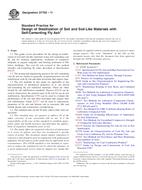
 ASTM D4223/D4223M-12..
ASTM D4223/D4223M-12..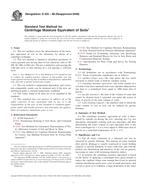 ASTM D425-88(2008)..
ASTM D425-88(2008)..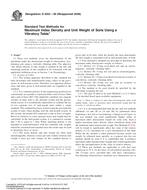 ASTM D4253-00(2006)..
ASTM D4253-00(2006)..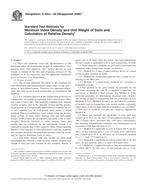 ASTM D4254-00(2006)e..
ASTM D4254-00(2006)e..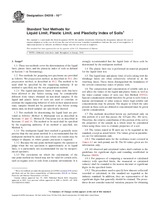 ASTM D4318-10e1
ASTM D4318-10e1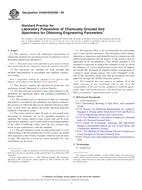 ASTM D4320/D4320M-09..
ASTM D4320/D4320M-09..
 Cookies
Cookies
